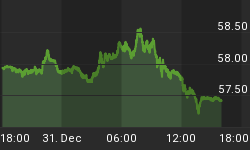
After 18 months of going sideways, the monetary base appears to be breaking out. Given QE3 where the Fed is buying $85 billion a month of securities consisting of $40 billion of mortgage-backed securities (MBS) and $45 billion of US Treasuries. The Fed also appears to be now buying roughly 80% of all US Treasury issues. No wonder the Fed's balance sheet has ballooned to over $3 trillion.
The monetary base is the narrowest definition of money in the economy and is highly liquid. It consists of currency plus the commercial banks reserves with the central bank in this case the Federal Reserve. If the monetary base were to be given a moniker, it would be M0. Add in demand deposits and one has M1 and then add to that other deposit accounts and less liquid savings accounts and one gets M2.
Since the financial crisis of 2008 the Federal Reserve has conducted quantitative easing (QE), an unconventional monetary policy used by central banks in an attempt to stimulate the economy when traditional monetary policy has become ineffective. Many say that QE itself is eventually ineffective, could become hyperinflationary, and is instead a "prop" for the commercial banks to shore up their balance sheets. Many believe that the major banks are burdened with trillions of dollars of mispriced derivatives and other assets and as such are effectively bankrupt.
QE is carried out by the central bank; in this case the Federal Reserve, purchasing financial assets from the commercial banks. QE puts money into the financial system which the Fed then hopes the commercial banks will lend out in order to stimulate the economy and create jobs.
QE1 was announced in December 2008 and effectively got underway at that time. The monetary base in September 2008 just before the collapse of Lehman Brothers was $874.8 billion. By the end of QE1 in March 2010 the monetary base grew to $2.2 trillion. QE1 saw the purchase of $300 billion of US Treasuries and $1.25 trillion of mortgage backed securities. QE2 got underway in August 2010 when the monetary base had slipped back to $2 trillion. QE2 was to purchase an additional $600 billion of US Treasuries. QE2 ran through to June 2011 and the monetary base grew to $2.7 trillion.
There was an interim program announced in September 2011 called Operation Twist whereby the Fed purchased long US Treasuries for short term US Treasuries. That program ended in December 2012. The monetary base was effectively flat during that time slipping back and forth between $2.5 trillion and $2.7 trillion. In September 2012, the Fed announced QE3. The most recent FOMC meeting confirmed that QE3 is to continue. There is no end date. The Fed will purchase $85 billion a month of US Treasuries and MBS. This past month the monetary base broke out over $2.7 trillion breaking the sideways pattern that had prevailed since September 2011.
Since the QE programs got underway gold rose from $800 in December 2008 to roughly $1,100 by March 2010 a gain of 37%. When QE2 got underway in August 2010 gold was trading at almost $1,200. By the time, QE2 ended in June 2012 gold had reached $1,500 a gain of another 25%. Gold eventually peaked in September 2011 just over $1,900. With QE3 underway if gold were to rise another 25% from current levels it could take it to over $2,000.
An interesting way of looking at the monetary base in relation to gold is how much gold would it take to fully back the monetary base. If gold is money as some contend then money should be backed by gold; in other words a return to a gold standard. In February 2001 when gold averaged $264, the monetary base stood at $620.3 billion. It took 2.3 billion ounces of gold to cover the monetary base. In January 2012 with gold averaging roughly $1,668, the monetary base was $2,750.7 billion. It took 1.7 billion ounces to cover the monetary base. That is an improvement but not substantial. On that basis gold still appears to be as cheap as it was in February 2001.
In January 1980 when gold peaked at $875, the average price for gold for the month was $669. The monetary base in January 1980 was $132.4 billion. It took only 198 million ounces of gold to cover the monetary base. But gold was in a bubble at that time. If the same thing were to occur today, gold would have to be trading at almost $14,000 in order to reach that low coverage. On that basis gold prices have a long way to go before reaching bubble territory.
















